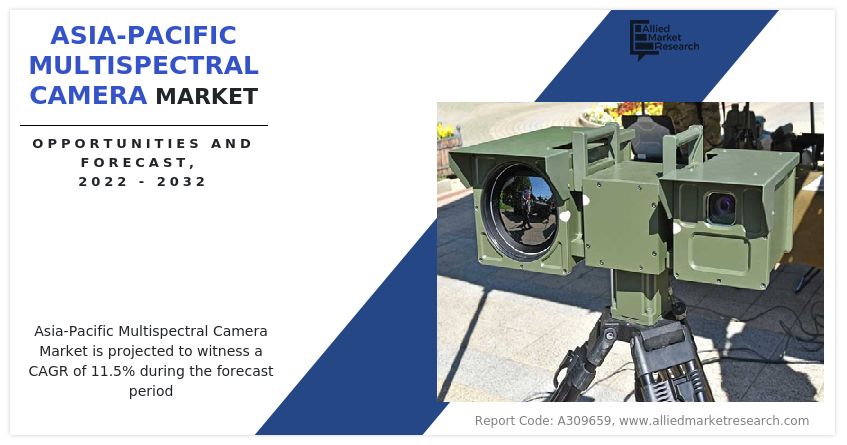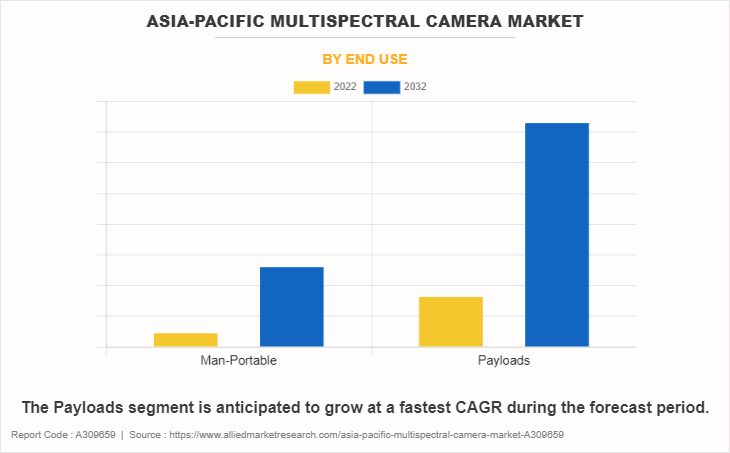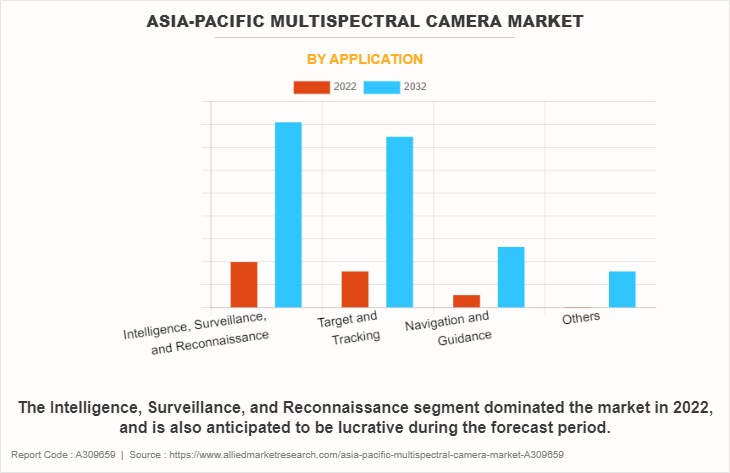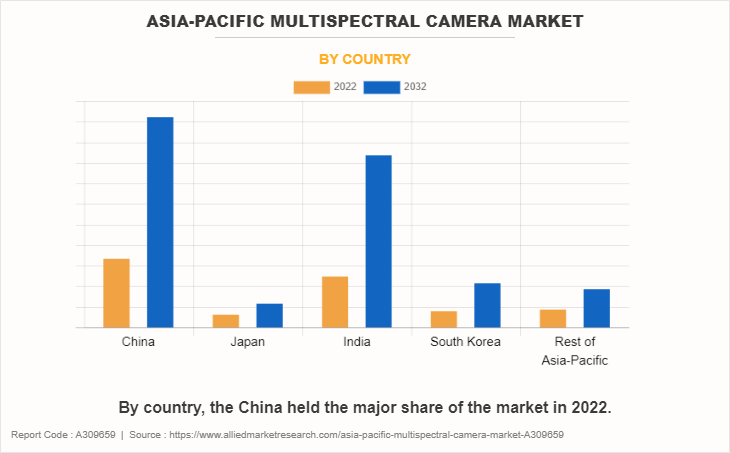An imaging equipment that can record data outside the visible light spectrum is called a multispectral camera. This implies that it has the ability to display things, such as infrared and ultraviolet wavelengths, that are not visible to human eyes. This enables the camera to be used across various applications in the defense sector such as intelligence, surveillance, and reconnaissance; target and tracking; navigation and guidance; and others.

The following factors are contributing to the growing popularity of multispectral camera applications for military use in the Asia-Pacific region:
Raising Defense Investments: Countries in the region are investing majorly in state-of-the-art technologies for surveillance and information gathering as a result of higher defense spending. Multispectral cameras offer special benefits for this purpose.
Border security and marine patrol: Asia-Pacific needs better monitoring capabilities due to its vast coastline and disputed borders. As multispectral cameras can see through foliage and low light, they are helpful for identifying dangers and illegal activity.
Target Identification and Tracking: The ability of multispectral cameras to record information beyond the visible spectrum allows for more precise target identification and tracking, even in challenging circumstances. This is essential for counterterrorism, combat operations, and reconnaissance.

Nonetheless, laws limiting the placement of these cameras in airspace and their distribution throughout sensitive regions are among the barriers impeding the integration of multispectral cameras. Furthermore, these high-end cameras come at a premium price. Thus, these are a few of the issues limiting the multispectral camera market's expansion throughout the area.
The COVID-19 pandemic has impacted the Asia-Pacific multispectral camera market, causing disruptions in the supply chain and production processes. Fluctuating demand and economic uncertainties have influenced market dynamics. Despite challenges, the market experienced a rapid recovery owing to the rise in investment by the defense sector in the procurement of aerial, land, and marine vehicles for their defense personnels.

The Asia-Pacific multispectral camera market is segmented into cooling technology, end use, imaging spectrum, application, and platform. On the basis of cooling technology, the market is bifurcated into cooled and uncooled. On the basis of end use the market is segmented into man-portable and payloads. On the basis of imaging spectrum, the market is categorized into visible/near-infrared (VNIR), short-wave infrared (SWIR), mid-wave infrared (MWIR), and long-wave infrared (LWIR). On the basis of application, the market is divided into intelligence, surveillance, and reconnaissance; target and tracking; navigation and guidance; and others. On the basis of platform, the market is segmented into land, air, and marine.

On the basis of countries, the Asia-Pacific multispectral camera market is analyzed across the China, Japan, India, South Korea, and the rest of Asia-Pacific. China is the largest market shareholder due to the country’s constantly increasing military expenditure to integrate advance technologies across all its defense platforms such as land, air, and marine is contributing to the high growth of the multispectral camera market across the country.
Competitive analysis and profiles of the major Asia-Pacific multispectral camera market players that have been provided in the report include Teledyne Digital Imaging Inc.; Leonardo DRS; Raytheon Technologies Inc (Collins Aerospace); HENSOLDT AG; SILIOS Technologies; JAI A/S, Telops Inc; L3Harris Technologies, Inc; Kappa optronics GmbH; Surface Optics Corporation. The key strategies adopted by the major players of the Asia-Pacific multispectral camera market are product launch and mergers & acquisitions.
The Asia-Pacific multispectral camera market is highly competitive, owing to the strong presence of existing vendors. Vendors of the Asia-Pacific multispectral camera market with extensive technical and financial resources are expected to gain a competitive advantage over their competitors because they can cater to market demands. The competitive environment in this market is expected to worsen as technological innovations, product extensions, and different strategies adopted by key vendors increase.
Key Developments & Strategies
- In May 2023, Mitsubishi Heavy Industries (MHI) was given a contract by the Japan Maritime Self-Defense Force (JMSDF) to deliver 12 multispectral observation pods for its SH-60J Seahawk helicopters.
- In April 2023, Advanced multispectral cameras for border security purposes have been successfully developed and tested by India's Defence Research and Development Organization (DRDO).
- In March 2023, The multispectral imaging-equipped CH-6B MALE (medium-altitude long-endurance) drone from China Electronics Technology Corporation (CETC) was unveiled.
KEY BENEFITS FOR STAKEHOLDERS
- This study comprises analytical depiction of the Asia-Pacific multispectral camera market size along with the current trends and future estimations to depict the imminent investment pockets.
- The overall Asia-Pacific multispectral camera market analysis is determined to understand the profitable trends to gain a stronger foothold.
- The report presents information related to key drivers, restraints, and opportunities with a detailed impact analysis.
- The current Asia-Pacific multispectral camera market forecast is quantitatively analyzed from 2022 to 2032 to benchmark the financial competency.
- Porter’s five forces analysis illustrates the potency of the buyers and suppliers in the smart display.
- The report includes the market share of key vendors in the Asia-Pacific multispectral camera market.
Asia-Pacific Multispectral Camera Market Report Highlights
| Aspects | Details |
| Market Size By 2032 | USD 1.2 billion |
| Growth Rate | CAGR of 11.5% |
| Forecast period | 2022 - 2032 |
| Report Pages | 110 |
| By Cooling Technology |
|
| By End Use |
|
| By Imaging Spectrum |
|
| By Application |
|
| By Platform |
|
| By Country |
|
| Key Market Players | L3Harris Technologies Inc., Israel Aerospace Industries Ltd., Raytheon Company, Thales Group, FLIR Systems Inc., Leonardo S.p.A., BAE Systems plc, General Dynamics Corporation, Honeywell International Inc., Teledyne Technologies Inc. |
The Asia-Pacific Multispectral Camera Market is projected to grow at a CAGR of 11.49% from 2022 to 2032
FLIR Systems Inc., Raytheon Company, Teledyne Technologies Inc., L3Harris Technologies Inc., Thales Group, BAE Systems plc, General Dynamics Corporation, Honeywell International Inc., Leonardo S.p.A., Israel Aerospace Industries Ltd. are the leading players in Asia-Pacific Multispectral Camera Market
1. The report provides a comprehensive analysis of the current market estimations through 2022-2032, which would enable the stakeholders to capitalize on prevailing market opportunities. 2. Major countries are mapped according to their revenue contribution to the asia-pacific multispectral camera market. 3. In-depth analysis of the asia-pacific multispectral camera market segmentation assists to determine the prevailing market opportunities. 4. Identify key players and their strategic moves in asia-pacific multispectral camera market. 5. Assess and rank the top factors that are expected to affect the growth of asia-pacific multispectral camera market. 6. Analyze the market factors in various countries and understand business opportunities. 7. Player positioning provides a clear understanding of the present position of key market players.
Asia-Pacific Multispectral Camera Market is classified as by cooling technology, by end use, by imaging spectrum, by application, by platform
Loading Table Of Content...
Loading Research Methodology...



